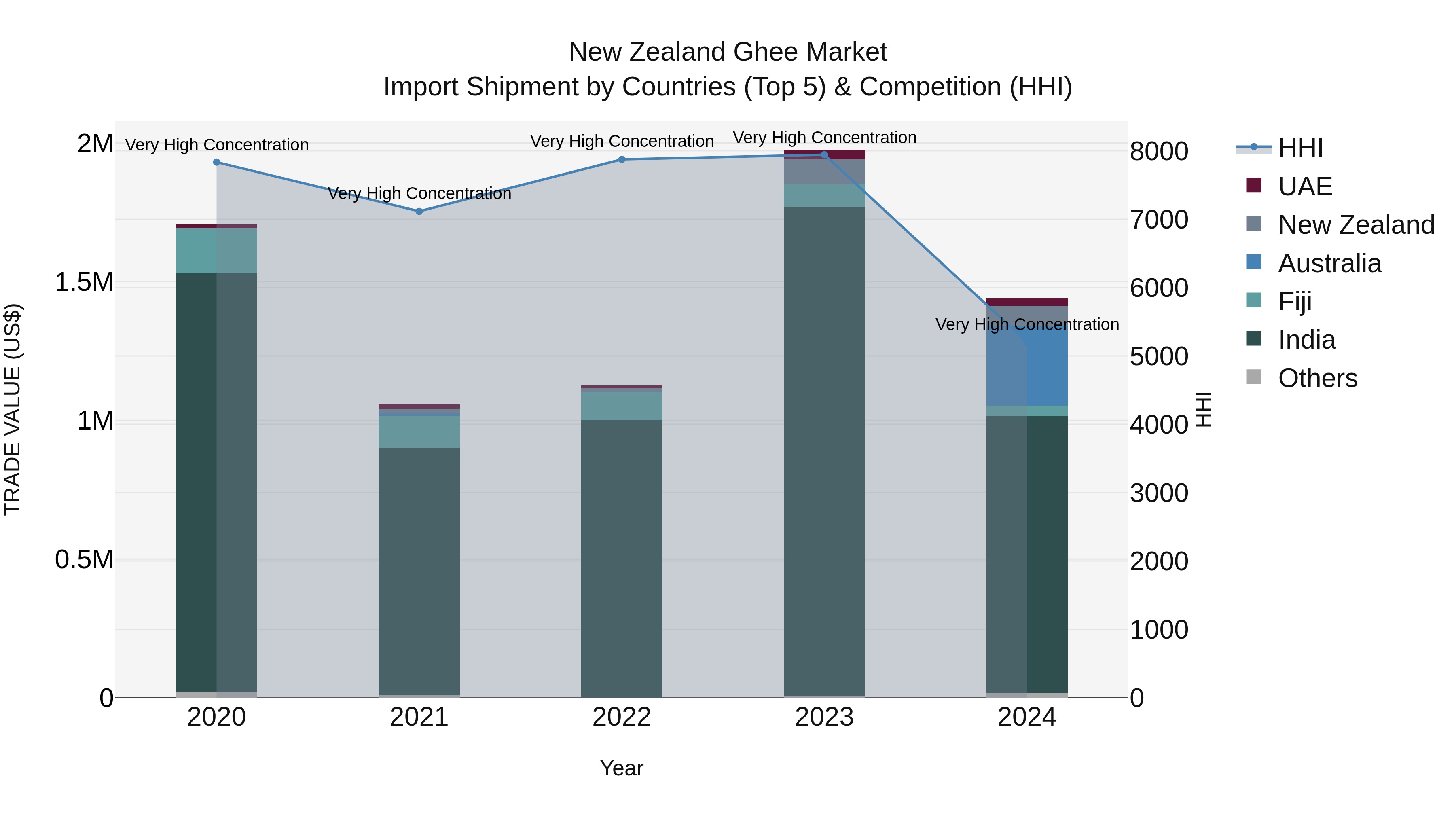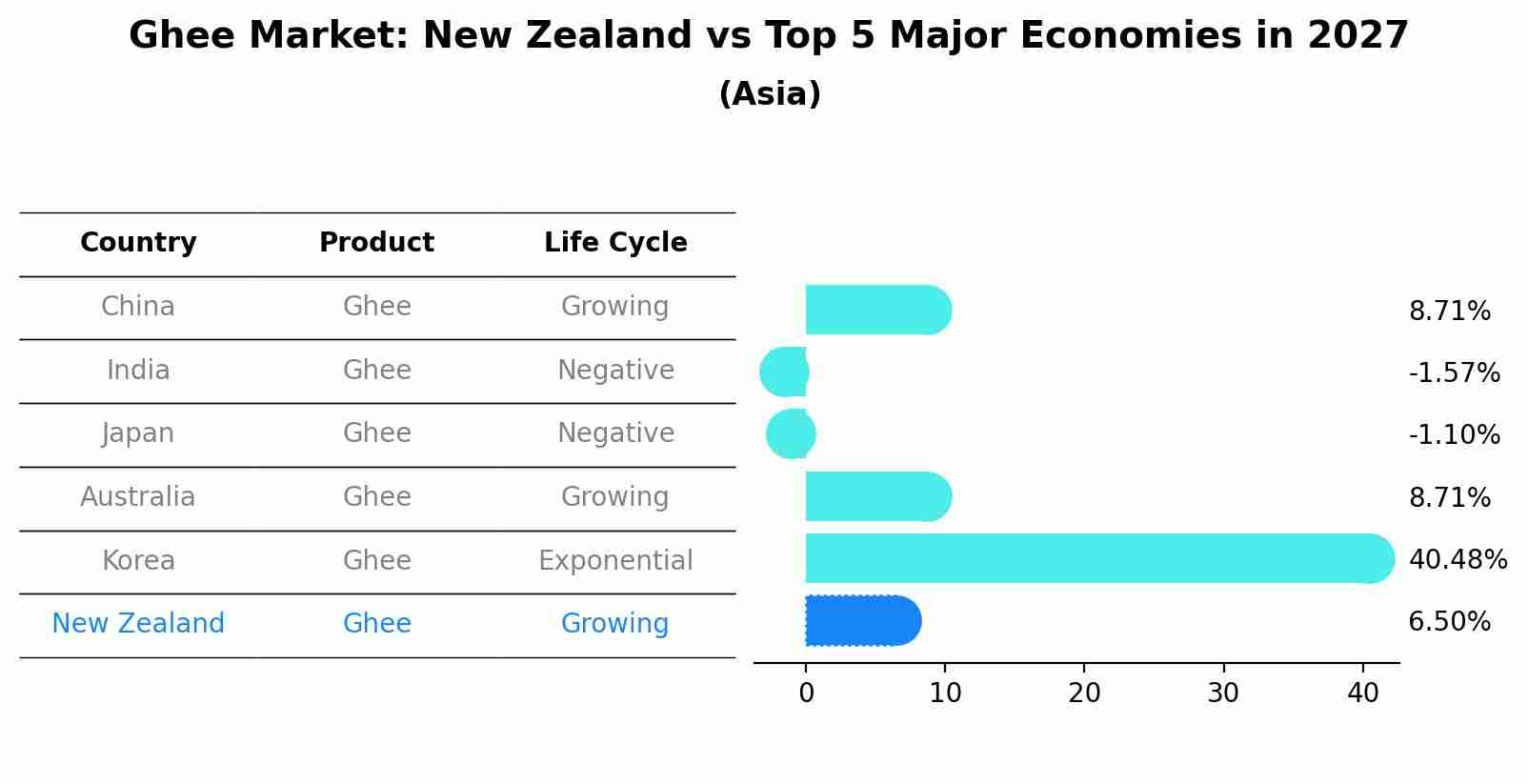New Zealand Ghee Market (2025-2031) | Analysis, Size, Outlook, Revenue, Trends, Companies, Industry, Value, Growth, Segmentation, Forecast & Share
| Product Code: ETC4849790 | Publication Date: Nov 2023 | Updated Date: Nov 2025 | Product Type: Market Research Report | |
| Publisher: 6Wresearch | Author: Sachin Kumar Rai | No. of Pages: 60 | No. of Figures: 30 | No. of Tables: 5 |
New Zealand Ghee Market Top 5 Importing Countries and Market Competition (HHI) Analysis
Despite a decline in the growth rate from 2023 to 2024, New Zealand continues to rely on key ghee import sources like India, Australia, and Fiji. The high Herfindahl-Hirschman Index (HHI) concentration indicates a market dominated by a few major players. The negative compound annual growth rate (CAGR) from 2020 to 2024 suggests challenges in the ghee import market. However, with diverse sources including the UAE, New Zealand is positioned to adapt to changing market dynamics and potentially improve growth prospects in the future.

Ghee Market: New Zealand vs Top 5 Major Economies in 2027 (Asia)
The Ghee market in New Zealand is projected to grow at a growing growth rate of 6.50% by 2027, highlighting the country's increasing focus on advanced technologies within the Asia region, where China holds the dominant position, followed closely by India, Japan, Australia and South Korea, shaping overall regional demand.

New Zealand Ghee Market Overview
In New Zealand, the ghee market reflects the nation`s rich dairy heritage and growing demand for premium quality dairy products. Ghee, a clarified butter with a nutty flavor and high smoke point, holds cultural significance and culinary versatility in various cuisines. The market is influenced by factors such as consumer preferences for natural and artisanal products, health-conscious trends, and the popularity of traditional cooking methods. With a focus on quality, authenticity, and sustainability, the ghee market caters to domestic consumption and export opportunities, leveraging New Zealand reputation for high-quality dairy products.
Drivers of the market
The ghee market in New Zealand is driven by the increasing consumer preference for natural and healthy food products. Ghee, a clarified butter commonly used in South Asian and Middle Eastern cuisines, is gaining popularity worldwide due to its rich flavor, nutritional benefits, and versatility in cooking. The growing awareness of the health benefits of ghee, such as its high smoke point, rich source of fat-soluble vitamins, and potential role in supporting digestive health, drives its consumption as a cooking oil and ingredient in various culinary applications. Additionally, the rising demand for premium and organic ghee products further stimulates market growth, with manufacturers focusing on product innovation, quality assurance, and sustainability.
Challenges of the market
The Ghee market in New Zealand encounters challenges concerning consumer preferences, competition from alternative products, and supply chain dynamics. Despite its cultural significance and nutritional benefits, ghee faces competition from butter, margarine, and plant-based alternatives. Moreover, ensuring product quality, shelf-life, and distribution efficiency are critical challenges for market players operating in a competitive landscape.
Government Policy of the market
The New Zealand government ensures food safety standards and regulations in the ghee market. Policies govern production practices, quality standards, and labeling requirements to maintain consumer confidence and uphold product integrity.
Key Highlights of the Report:
- New Zealand Ghee Market Outlook
- Market Size of New Zealand Ghee Market, 2024
- Forecast of New Zealand Ghee Market, 2031
- Historical Data and Forecast of New Zealand Ghee Revenues & Volume for the Period 2021-2031
- New Zealand Ghee Market Trend Evolution
- New Zealand Ghee Market Drivers and Challenges
- New Zealand Ghee Price Trends
- New Zealand Ghee Porter`s Five Forces
- New Zealand Ghee Industry Life Cycle
- Historical Data and Forecast of New Zealand Ghee Market Revenues & Volume By Source for the Period 2021-2031
- Historical Data and Forecast of New Zealand Ghee Market Revenues & Volume By Cow for the Period 2021-2031
- Historical Data and Forecast of New Zealand Ghee Market Revenues & Volume By Buffalo for the Period 2021-2031
- Historical Data and Forecast of New Zealand Ghee Market Revenues & Volume By Mixed for the Period 2021-2031
- Historical Data and Forecast of New Zealand Ghee Market Revenues & Volume By End-use for the Period 2021-2031
- Historical Data and Forecast of New Zealand Ghee Market Revenues & Volume By Retail for the Period 2021-2031
- Historical Data and Forecast of New Zealand Ghee Market Revenues & Volume By Institutional for the Period 2021-2031
- Historical Data and Forecast of New Zealand Ghee Market Revenues & Volume By Distribution Channel for the Period 2021-2031
- Historical Data and Forecast of New Zealand Ghee Market Revenues & Volume By Supermarkets/Hypermarkets for the Period 2021-2031
- Historical Data and Forecast of New Zealand Ghee Market Revenues & Volume By Convenience Stores for the Period 2021-2031
- Historical Data and Forecast of New Zealand Ghee Market Revenues & Volume By Specialty Stores for the Period 2021-2031
- Historical Data and Forecast of New Zealand Ghee Market Revenues & Volume By Online for the Period 2021-2031
- Historical Data and Forecast of New Zealand Ghee Market Revenues & Volume By Others for the Period 2021-2031
- New Zealand Ghee Import Export Trade Statistics
- Market Opportunity Assessment By Source
- Market Opportunity Assessment By End-use
- Market Opportunity Assessment By Distribution Channel
- New Zealand Ghee Top Companies Market Share
- New Zealand Ghee Competitive Benchmarking By Technical and Operational Parameters
- New Zealand Ghee Company Profiles
- New Zealand Ghee Key Strategic Recommendations
Frequently Asked Questions About the Market Study (FAQs):
1 Executive Summary |
2 Introduction |
2.1 Key Highlights of the Report |
2.2 Report Description |
2.3 Market Scope & Segmentation |
2.4 Research Methodology |
2.5 Assumptions |
3 New Zealand Ghee Market Overview |
3.1 New Zealand Country Macro Economic Indicators |
3.2 New Zealand Ghee Market Revenues & Volume, 2021 & 2031F |
3.3 New Zealand Ghee Market - Industry Life Cycle |
3.4 New Zealand Ghee Market - Porter's Five Forces |
3.5 New Zealand Ghee Market Revenues & Volume Share, By Source, 2021 & 2031F |
3.6 New Zealand Ghee Market Revenues & Volume Share, By End-use, 2021 & 2031F |
3.7 New Zealand Ghee Market Revenues & Volume Share, By Distribution Channel, 2021 & 2031F |
4 New Zealand Ghee Market Dynamics |
4.1 Impact Analysis |
4.2 Market Drivers |
4.2.1 Increasing consumer awareness about the health benefits of ghee |
4.2.2 Growing demand for organic and grass-fed dairy products |
4.2.3 Rising popularity of traditional and ethnic cuisines that use ghee |
4.3 Market Restraints |
4.3.1 Fluctuating prices of raw materials such as milk and butter |
4.3.2 Intense competition from alternative cooking oils and spreads |
4.3.3 Regulatory challenges related to food safety and labeling requirements |
5 New Zealand Ghee Market Trends |
6 New Zealand Ghee Market Segmentations |
6.1 New Zealand Ghee Market, By Source |
6.1.1 Overview and Analysis |
6.1.2 New Zealand Ghee Market Revenues & Volume, By Cow, 2021-2031F |
6.1.3 New Zealand Ghee Market Revenues & Volume, By Buffalo, 2021-2031F |
6.1.4 New Zealand Ghee Market Revenues & Volume, By Mixed, 2021-2031F |
6.2 New Zealand Ghee Market, By End-use |
6.2.1 Overview and Analysis |
6.2.2 New Zealand Ghee Market Revenues & Volume, By Retail, 2021-2031F |
6.2.3 New Zealand Ghee Market Revenues & Volume, By Institutional, 2021-2031F |
6.3 New Zealand Ghee Market, By Distribution Channel |
6.3.1 Overview and Analysis |
6.3.2 New Zealand Ghee Market Revenues & Volume, By Supermarkets/Hypermarkets, 2021-2031F |
6.3.3 New Zealand Ghee Market Revenues & Volume, By Convenience Stores, 2021-2031F |
6.3.4 New Zealand Ghee Market Revenues & Volume, By Specialty Stores, 2021-2031F |
6.3.5 New Zealand Ghee Market Revenues & Volume, By Online, 2021-2031F |
6.3.6 New Zealand Ghee Market Revenues & Volume, By Others, 2021-2031F |
7 New Zealand Ghee Market Import-Export Trade Statistics |
7.1 New Zealand Ghee Market Export to Major Countries |
7.2 New Zealand Ghee Market Imports from Major Countries |
8 New Zealand Ghee Market Key Performance Indicators |
8.1 Consumer purchase intent for ghee products |
8.2 Number of new product launches in the ghee market |
8.3 Growth in the number of retail outlets stocking ghee products |
8.4 Percentage of consumers willing to pay a premium for high-quality ghee |
8.5 Adoption rate of ghee in mainstream recipes and cooking practices |
9 New Zealand Ghee Market - Opportunity Assessment |
9.1 New Zealand Ghee Market Opportunity Assessment, By Source, 2021 & 2031F |
9.2 New Zealand Ghee Market Opportunity Assessment, By End-use, 2021 & 2031F |
9.3 New Zealand Ghee Market Opportunity Assessment, By Distribution Channel, 2021 & 2031F |
10 New Zealand Ghee Market - Competitive Landscape |
10.1 New Zealand Ghee Market Revenue Share, By Companies, 2024 |
10.2 New Zealand Ghee Market Competitive Benchmarking, By Operating and Technical Parameters |
11 Company Profiles |
12 Recommendations | 13 Disclaimer |
- Single User License$ 1,995
- Department License$ 2,400
- Site License$ 3,120
- Global License$ 3,795
Search
Thought Leadership and Analyst Meet
Our Clients
Related Reports
- Afghanistan Apparel Market (2026-2032) | Growth, Outlook, Industry, Segmentation, Forecast, Size, Companies, Trends, Value, Share, Analysis & Revenue
- Canada Oil and Gas Market (2026-2032) | Share, Segmentation, Value, Industry, Trends, Forecast, Analysis, Size & Revenue, Growth, Competitive Landscape, Outlook, Companies
- Germany Breakfast Food Market (2026-2032) | Industry, Share, Growth, Size, Companies, Value, Analysis, Revenue, Trends, Forecast & Outlook
- Australia Briquette Market (2025-2031) | Growth, Size, Revenue, Forecast, Analysis, Trends, Value, Share, Industry & Companies
- Vietnam System Integrator Market (2025-2031) | Size, Companies, Analysis, Industry, Value, Forecast, Growth, Trends, Revenue & Share
- ASEAN and Thailand Brain Health Supplements Market (2025-2031) | Strategy, Consumer Insights, Analysis, Investment Trends, Opportunities, Growth, Size, Share, Industry, Revenue, Segments, Value, Segmentation, Supply, Forecast, Restraints, Outlook, Competition, Drivers, Trends, Demand, Pricing Analysis, Competitive, Strategic Insights, Companies, Challenges
- ASEAN Bearings Market (2025-2031) | Strategy, Consumer Insights, Analysis, Investment Trends, Opportunities, Growth, Size, Share, Industry, Revenue, Segments, Value, Segmentation, Supply, Forecast, Restraints, Outlook, Competition, Drivers, Trends, Demand, Pricing Analysis, Competitive, Strategic Insights, Companies, Challenges
- Europe Flooring Market (2025-2031) | Outlook, Share, Industry, Trends, Forecast, Companies, Revenue, Size, Analysis, Growth & Value
- Saudi Arabia Manlift Market (2025-2031) | Outlook, Size, Growth, Trends, Companies, Industry, Revenue, Value, Share, Forecast & Analysis
- Uganda Excavator, Crane, and Wheel Loaders Market (2025-2031) | Strategy, Consumer Insights, Analysis, Investment Trends, Opportunities, Growth, Size, Share, Industry, Revenue, Segments, Value, Segmentation, Supply, Forecast, Restraints, Outlook, Competition, Drivers, Trends, Demand, Pricing Analysis, Competitive, Strategic Insights, Companies, Challenges
Industry Events and Analyst Meet
Whitepaper
- Middle East & Africa Commercial Security Market Click here to view more.
- Middle East & Africa Fire Safety Systems & Equipment Market Click here to view more.
- GCC Drone Market Click here to view more.
- Middle East Lighting Fixture Market Click here to view more.
- GCC Physical & Perimeter Security Market Click here to view more.
6WResearch In News
- Doha a strategic location for EV manufacturing hub: IPA Qatar
- Demand for luxury TVs surging in the GCC, says Samsung
- Empowering Growth: The Thriving Journey of Bangladesh’s Cable Industry
- Demand for luxury TVs surging in the GCC, says Samsung
- Video call with a traditional healer? Once unthinkable, it’s now common in South Africa
- Intelligent Buildings To Smooth GCC’s Path To Net Zero


















